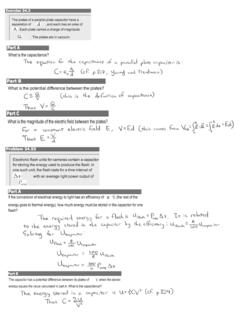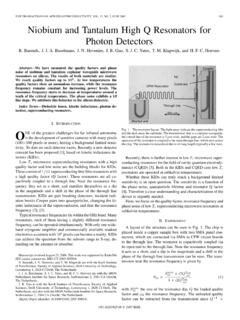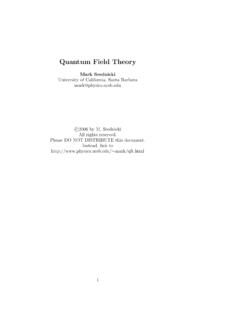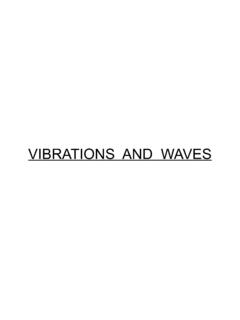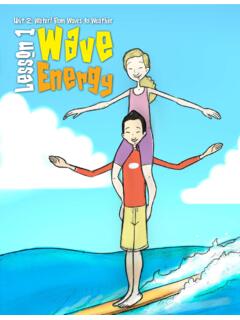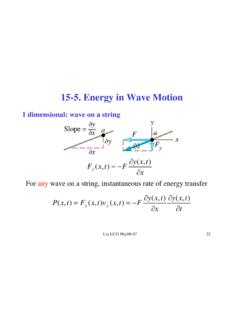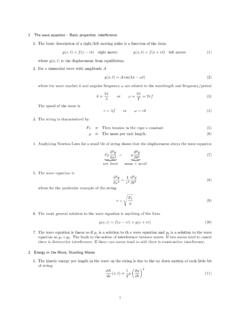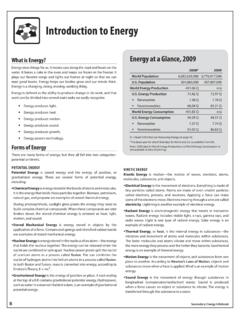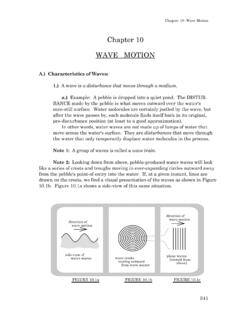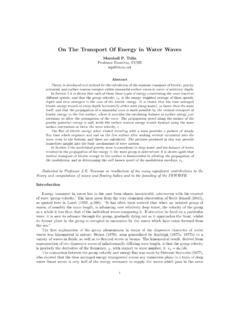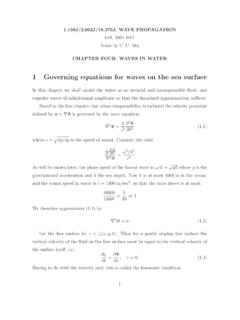Transcription of MECHANICAL WAVES AND SOUND - UCSB Physics
1 MECHANICAL WAVES AND SOUND WAVES Substances have a stable equilibrium state Uniform pressure everywhere throughout the substance Atomic springs are at their equilibrium length Can make a wave by disturbing the equilibrium Physics definition of a wave A vibration which moves through a substance Each individual molecule undergoes ..but energy moves from molecule to moleculeWave motionMoleculemotion Wavelength Vibrational motion repeats itself after one period Notice that the wave is moving during this time Wavelength Distance moved by a wave during one period Wavelength is symbolized by the Greek letter lambda: Wave Speed Calculating wave speed Wave moves one wavelength every period Wave speed depends on the substance Called the medium of the wave Wave speed is a constant in a specific medium So if the frequency of a wave.
2 Wavelength must decrease!WaveSpeed=wavelengthperiod=wave length frequencyv= f Common Wave Examples SOUND WAVES produced by: Quick changes in pressure Vibrating objects WAVES on a string: String under tension shaking it produces a wave Water surface WAVES Produced by disturbing a flat water surface Electromagnetic WAVES Produced by wiggling charged particles Transverse vs. Longitudinal WAVES Two different motions to describe in a wave: motion of the wave's energy motion of individual molecules of the wave Transverse WAVES Two motions are perpendicular WAVES on a string, water surface WAVES Longitudinal WAVES Two motions are parallel SOUND WAVES WAVES can have both transverse and longitudinal motion Earthquakes, ocean WAVES produce rolling motion WAVES On a String Medium (string) is 1-Dimensional Relatively simple mathematically y(x,t) Easy to visualize Wave speed on a string Depends on the string tension FT and mass density Speed is the same for all frequencies and wavelengths!
3 Yxvwave= FT SOUND and Hearing SOUND wave created by push/pull on a medium Usually by vibrating an object at some frequency Vocal cords; guitar string; loudspeaker Detecting a SOUND wave Allow vibrating medium to push/pull on an ..and measure the vibrationsHuman ear can detect SOUND WAVES with frequencies from 20 Hz to 20,000 Hz(This range narrows with age) Compressions and Rarefactions SOUND is a longitudinal wave Each molecule moves parallel to the energy of the wave Molecules are pushed/pulled by air pressure Air is compressed in some spots; stretched in others Compressed areas are called compressionsStretched areas are called rarefactions Speed of SOUND WAVES Two factors affect the speed of SOUND WAVES : Density of the medium Stiffness of the medium atomic springs Solids and liquids are more rigid than gases So SOUND WAVES move faster!
4 Speed of SOUND in air About 340 m/sec varies strongly with temperature Relatively slow at large distance, can notice delay Loudness of SOUND WAVES Decibels Amplitude of SOUND wave pressure variations How far above/below atmospheric pressure Decibel scale Converts intensity of pressure variations to a loudness Far from SOUND source intensity weakens Decibel scale: Based on human ears Quietest SOUND a human can hear = 0 dB Normal conversation = 60 dB Loud rock concert = 110 dB =10log II0 I0=10 12Wm2I 1r2 Doppler Effect If a wave source or listener moves: Wavelength and frequency of the wave are affected During one wave period source-listener distance changes Source/listener moving toward each other: Wavelength is decreased; frequency is increased Source/listener moving away: Wavelength is increased; frequency is decreasedfL= v vLv vS fS Example: Bat Sonar Bats can locate small objects in the dark Using SOUND WAVES !
5 Ultra-high frequency ( > 40kHz ) Can detect location of object using delay time a bat knows the speed of SOUND Can detect velocity of object using Doppler Effect Because reflected wave has different frequency Shock WAVES Source moves through medium Doppler effect What if a source moves near the speed of SOUND ? WAVES start to overlap and produce a shock wave Shock WAVES take up small volume but have large energy Mathematics of Wavesy x,t =Asin 2 tT x Accounts for the shape of the wave and its motion over time Wave Phase Phase of a wave Describes how far along in cycle a wave is sin() function repeats when argument increases by 360o A whole wavelength has 360o of phase (or 2 radians)90o180o270o360oTwo WAVES can have a phase difference or relative phase as shown below Wave Interference What happens when two WAVES collide?
6 They both push/pull on the medium Result is a mix of the two wavesConstructive Interference- WAVES are in phase - phase difference = 0- total wave large AmpDestructive Interference- WAVES are out of phase- phase difference = 180o- total wave small AmpIn General- 0 < phase difference < 180o- total wave medium Amp Interference ExamplesBeatsWhen adding 2 WAVES of slightly different frequencies: WAVES alternate between in phase and out of phase Amplitude goes up and down at beat frequency Used in tuning musical instrumentsfbeat= f1 f2 Path Length DifferenceWhen 2 WAVES travel different distances to reach a point:They develop a phase differenceConstructiveDestructiveNote: m = any integer (0, 1, 2.)
7 L=m L= m 12 Standing WAVES When a wave interferes with its own reflection: Result a wave pattern that stands instead of traveling Reflections are caused by a change in medium To produce standing WAVES : Generate a wave in a medium with boundariesNodeAntinode Stringed Instruments Made from strings with fixed ends WAVES reflect from the ends to produce standing WAVES Must have specific like resonances of the string n=2 Lnfn=v n=n v2L fn=nf1 Harmonic series Harmonic Frequencies Timbre Stringed instruments harmonic frequencies Personality of a particular instrument comes from its combination of harmonicsOboe SOUND waveform Oboe recipe of frequenciesA different instrument would have a different recipe of harmonic frequencies.
8 Even though it plays the same note Wind Instruments Produce a standing wave in air General rule: open ends of tube are antinodes n=2 Lnfn=v n=n v2L fn=nf1 Both ends open(same as forstringed instruments)One end closed n=4 Lnfn=v n=n v4L fn=nf1 Odd n only!!

